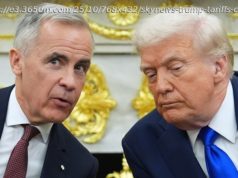President Trump’s repudiation of nation-building is popular, but may not prove practical in Afghanistan.
Over the decades, the concept of “nation-building” has been in and out of favor with successive American administrations. President Trump says he wants no part of it in Afghanistan.
But past presidents have found that when it comes to foreign interventions, it’s very difficult to achieve and sustain military gains in the absence of a stable, functioning government and the institutions that go along with it. That’s one of the main arguments in favor of nation-building — or state-building, as some, including President George W.’s Bush’s Secretary of State Condoleezza Rice chose to call it.
Here’s a look at where broad assistance has worked and where it hasn’ t, and some of the lessons about why.
Yes. After World War II, the United States embarked on a breathtakingly ambitious initiative known as the Marshall Plan, named for then-Secretary of State George Marshall, to rebuild the ruined economies of Western Europe — including that of vanquished foe Germany. A similarly wide-ranging reconstruction effort was undertaken in defeated Japan. Historians regard this assistance as a resounding success, and the U. S. now counts the recipients, including Germany and Japan, among its closest allies.
A more recent example came in Colombia, where multifaceted assistance was dispensed over more than a decade aimed at curbing the raging violence associated with drug trafficking, and winding down a 40-year-old civil war. Broad-based U. S. aid was also extended, with a reasonable degree of efficacy, in the former Yugoslavia after the shattering Balkan wars of the 1990s.
As a policy concept, it’s had a “bad odor” for at least 15 years, mainly because of the U. S.-led war in Iraq, said Daniel Runde of the Center for Strategic and International Studies in Washington. In the U. S., general disillusionment with the aims and course of the Iraq conflict melded with anger over the expense and difficulties encountered in the rebuilding of the institutions of a nation of 25 million people — necessitated by the disastrous decision to essentially deconstruct its state apparatus.
“It was never going to succeed, ” Adil Shamoo, a Baghdad-born analyst at the left-leaning Institute for Policy Studies in Washington, said of the multibillion-dollar reconstruction effort. “You had resistance to foreign occupiers telling people what to do, and as time passes, an underground movement evolves out of a sense of nationalism, and then everything has backfired.”
In Afghanistan, the picture is more complicated. The wreckage of the Twin Towers was still smoldering when the U. S.-led military intervention began in 2001. The swift toppling of the Taliban movement, which had given haven to Osama bin Laden as Al Qaeda plotted the Sept. 11 attacks, ultimately bogged down in continuing insurgency, becoming the United States’ longest war. The nearly 16-year conflict is now widely viewed by the U. S. public as a quagmire and recently was characterized as a stalemate by its American commander.
In part because of the medieval cruelty of prewar Taliban rule, particularly its systematic oppression of girls and women, there was strong support on the part of U. S. allies and the American public for rebuilding roads, schools and clinics, but also creating, almost from scratch, institutions such as the courts and the military. All that took place alongside a U. S. military presence that reached a peak of 100,000 troops under President Obama before the drawdown that left about 8,500 in place today.
As the years passed and the Afghan war ’s unpopularity grew, support waned for aid programs because of brazen graft, massive and well-documented waste of funds, and deteriorating security for development projects as the Taliban regrouped. Doubts about the Afghanistan reconstruction effort were exploited by Donald Trump as he began cultivating his political base, years before the businessman and reality show star became a presidential candidate.
Yes and no, analysts say. When Trump declared that “we are not nation-building.… We are killing terrorists, ” those were words likely meant to immunize him against disappointment among supporters who had reveled in his staunchly noninterventionist campaign rhetoric and were unhappy about committing more troops to the conflict.
As a practical matter, though, Afghanistan’s international partners, including the United States, have committed themselves through 2020 to spending about $3 billion annually for development assistance, analyst Runde said. Most of that is for programs that would fit neatly into the old nation-building template.
“It’s fine to oppose ‘nation-building,’ but you can’ t have it both ways, ” tweeted Brookings Institution senior analyst Shadi Hamid, coauthor of a forthcoming book about governance in conflict areas. “There’s no way to ‘defeat’ the Taliban without much-improved governance.”
Even if Trump’s repudiation of nation-building was largely for show, there may have been some harsh ground truth in the president’s assertion that “we will no longer use American military might to construct democracies in faraway lands.”
He presumably doesn’ t want to see the Afghan government’s authority deteriorate to the point that it becomes a failed state and a terrorist haven. But he also signaled indifference as to whether Afghanistan’s fragile democracy survives, so long as the government doesn’ t fall apart completely, analysts said.
That might include a political role for the Taliban, Trump acknowledged in his address Monday night.
“What he’s saying is that he’s not interested in values and principles” on which Afghanistan’s system of governance is based, said Harris Mylonas, associate dean for research at George Washington University’s Elliott School of International Affairs and the author of “The Politics of Nation-Building.
Start
United States
USA — Political No nation-building in Afghanistan? Easier said than done, experts say






